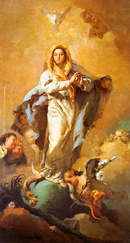|
 |
 |

Fresh-cut flowers may be used on the altar for ornamentation
but they should not distract from the essentials. They must
not be placed on the 'mensa' (i.e., the altar itself) but rather
on the gradines (i.e.,the 'steps'). They should be placed between
the candlesticks. Flowers may never be on top of the tabernacle
or before the door of the tabernacle or in front of the crucifix.
Artificial flowers must never be used nor may 'potted' plants
be used (except on Christmas and Easter).
Flowers may not be used when the vestments are black or violet
(the exceptions being: Gaudete Sunday, Laetare Sunday and the
Vigil of the Nativity and the feast of the Holy Innocents).
The practice of adorning the altar on feast days with vases
containing fragrant floral and foliate bouquets is approved
and commended, though not prescribed.
a) If natural flowers cannot be obtained, artificial flowers
of silk or of other precious materials are permitted.
b) The bouquets should be tastefully--arranged in the vases,
and the vases should be placed between candlesticks. A floral
decoration should not aim at rendering the altar candlesticks
a inconspicuous as possible since candlesticks are required
altar appointments.
c) It is not forbidden to adorn the altar with flowers on the
following days: on the feast of the Holy Innocents; on the Rogation
days : on common vigils; on Septuagesima, Sexagesima. and Quinquagesima
Sundays.
d) It is forbidden to adorn the altar with flowers at the following
times:
1. During Advent when the Office is of the Season except on
the 3rd Sunday and on the Monday, Tuesday and Thursday following,
and except on the vigil of Christmas and during such functions
as Benediction. Novena devotions, a First Communion Mass,
and the like.
2. During Advent when the Office is not of the Season, but
then only if and while a Mass of the Season is celebrated
as e.g. on an Ember day.
3. On Candlemas day, but only during the blessing of the candles
before the principal Mass.
4. During Lent and Passiontide when the Office is of the Season,
except on the 4th Sunday of Lent and during the Mass of Holy
Thursday and Holy Saturday and except during such functions
as Benediction, Novena devotions, a First Communion Mass,
and the like.
5. During Lent and Passiontide_ when the Office is not of
the Season, but then only if and while a Mass of the Season
is celebrated.
6. On the vigil of Pentecost, but only during the function
immediately preceding the principal Mass.
7. On the Ember days in September, but only if and while the
Mass of the Ember day is celebrated.
8. During the Office of the Dead and a Mass of Requiem.
9. During a votive Mass of the Passion.
|
|






